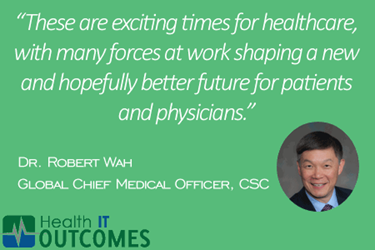What Physicians Need To Know For 2017

By Dr. Robert Wah, Global Chief Medical Officer, CSC
These are exciting times for healthcare, with many forces at work shaping a new and hopefully better future for patients and physicians. For example, we are seeing great advances in genetic and immunology fields that will dramatically improve our abilities to diagnose and treat diseases in addition to our long heritage of improving surgical techniques and medication development. Medical science, technology, politics, and society as a whole are seeing significant changes, but nothing like the increased focus on population health that will move us more towards prevention and away from intervention.
Technology Advancement
In the area of technology, we will hopefully soon reap the benefits of converting from paper to digital. We still have interface, usability, workflow, and interoperability concerns that must be solved, but on a digital platform we will be able to do advanced analytics and personalized medicine like never before.
Technology will also connect physicians with patients in new ways outside the four walls of the office. Patients want the digital benefits they see in the other parts of their lives as part of consumer convenience disruption. With digitization, we also can’t ignore the ongoing threat of breaches of the digital systems. I believe we are in an arms race with criminal elements in healthcare, and unfortunately in this area we are behind. We must employ industrial strength cybersecurity with learnings from other industries applied to healthcare.
Transition To Value-Based Care
The shift in the legislative and regulatory political space will have momentous changes that will have a resounding effect on many areas including healthcare. As a physician, I would like to see us design the ideal system of care and delivery that gets the best health and outcomes for patients in a cost efficient way, then craft a payment system that will facilitate this improved delivery system. Unfortunately, the balance is leaning much more towards changing the payment system then our ability to transition changes in the delivery system.
One significant change in payments, making this a game-changing year for physicians, is the final Medicare Access and CHIP Reauthorization Act (MACRA) Rule. We finally got the Sustainable Growth Rate (SGR) repealed when I was AMA President, and now with MACRA we must get ready to be successful in our practices and in taking the best care of our patients. I now say, it is time to prepare and not be complacent.
Despite the relaxed rule in year one (2017), by having the option to Pick Your Pace doctors should certainly not sit back and keep the status quo. Wondering if the rules will be changed or waiting until 2018 when they have to fully participate is like cramming the night before exam in medical school. It will set you back and put you in the lower half of the curve from the start. This is a dangerous strategy for doctors, getting behind in implementing measures, like it does in your studies, makes it practically impossible to catch up.
In 2017, take advantage of The Centers for Medicare & Medicaid Services' (CMS) lenient approach and get ahead of the group as you will be publicly ranked and the negative payment penalties will be paid to those in the top 25 percent.
Patient Engagement
One course of action to take now is to implement a Chronic Care Management (CCM) program for your high-risk and rising-risk patients that will not only benefit by seeing improved outcomes over time, but will create loyal beneficiaries of your practice. CMS has also improved upon their revenue incentives to include initial visits, ease enrollment process, and encourage continued engagement with the patient on their terms.
Implementing CMS code CPT 99490 (chronic care management services) now will prepare your office with the foundation and workflow changes needed to be successful in the MACRA program. The core elements of CCM — care coordination, patient-centered approach of involving patients’ care team, and beneficiary engagement — are just some of the areas that, if done correctly, can be counted towards many of the MIPS measures to help prepare your practice to be in the top rankings.
As uncertain as the future may be, I always see change as an opportunity we can learn from and maximize upon. 2017 is a year of tremendous change and opportunity with strong potential for finally understanding high-need patient populations, involving their participation for long-term success and strengthening our connection with one patient at a time.
About The Author
Dr. Robert Wah is CSC’s Global Chief Medical Officer and former President of AMA. He developed the CSC Healthcare point of view: CSC is Transforming Healthcare with Better Information for Better Decisions. At HHS, Dr. Wah served as the first Deputy National Coordinator for Health IT, where he set up the ONC (Office of the National Coordinator for Health IT) and was Chief Operating Officer. Since 2007, Dr. Wah has been routinely ranked in Modern Healthcare’s “50 Most Powerful Physician Executives.”
